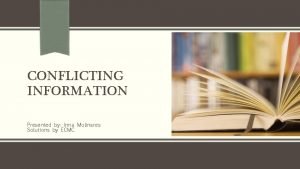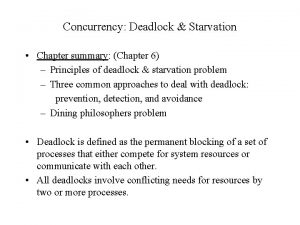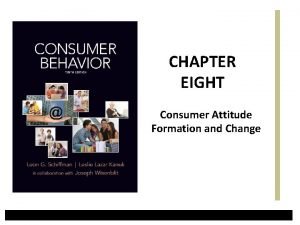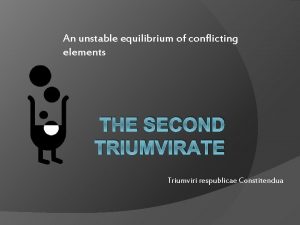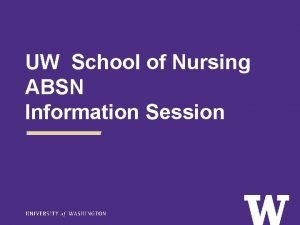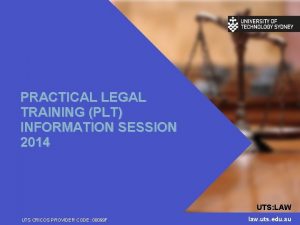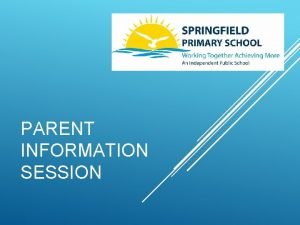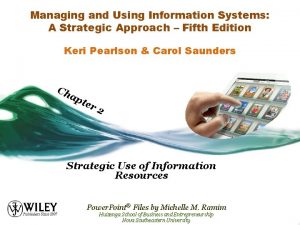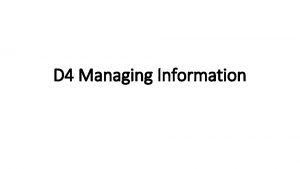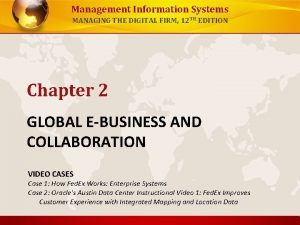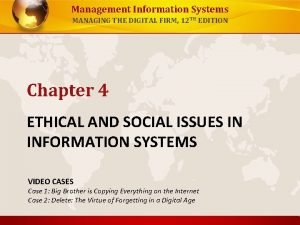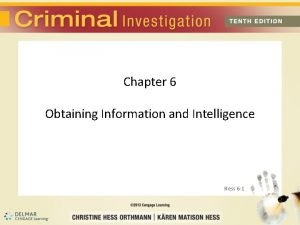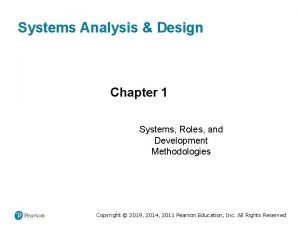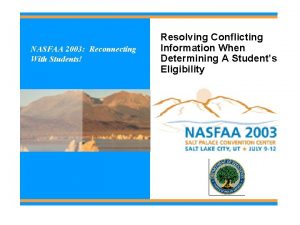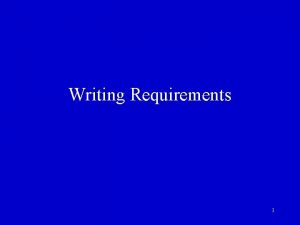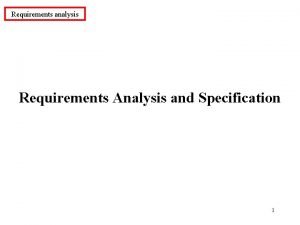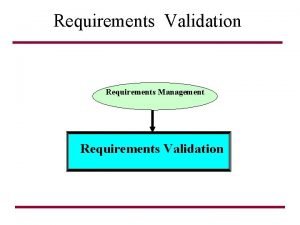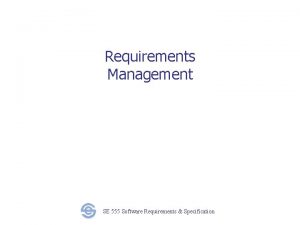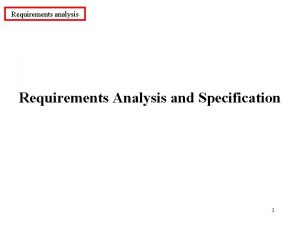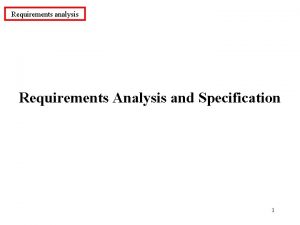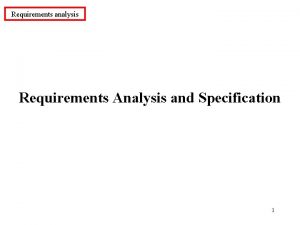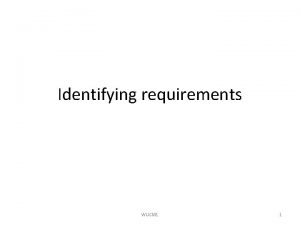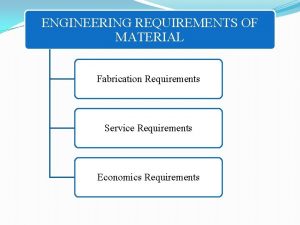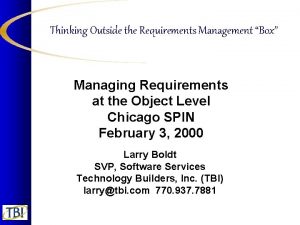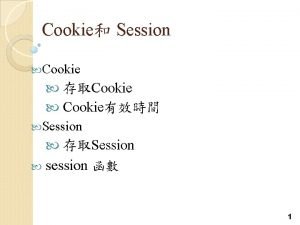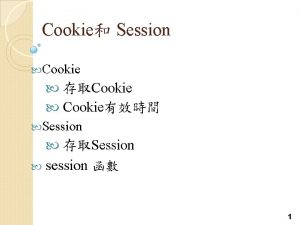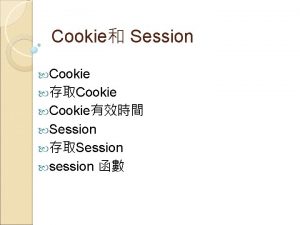Session 32 Managing the Conflicting Information Requirements of





























- Slides: 29

Session 32 Managing the Conflicting Information Requirements of the Regulations Carney Mc. Cullough Anthony Jones Office of Postsecondary Education

Session Overview q What is and what is not conflicting information under the q q q q regulations Sources of conflicting information What constitutes resolution of conflicting information How long you have to resolve conflicting information Timing of institution’s receipt of conflicting information Handling conflicts in taxable and untaxed income Good practices vs. what is required When you should contact the Office of the Inspector General 1

What is Conflicting Information under the Regulations? q Information obtained that is different from information previously available to the institution and that impacts a student’s eligibility for aid q Includes, but is not limited to, verification 2

What is Conflicting Information under the Regulations? (cont’d) q Conflicting information may include information related to a student’s eligibility such as: – – citizenship status, accuracy of SSN, default or overpayment status, changes in student’s academic status (including grade level progression), – COA elements, – other student financial assistance or resources, and – inconsistent information used in the calculation of the EFC 3

What is Conflicting Information under the Regulations? (cont’d) q § 668. 16(f) of the General Provisions regulations states that an institution has the administrative capability to administer the Title IV programs if, among other things, it. . . q “Develops and applies an adequate system to identify and resolve discrepancies in the information that the institution receives from different sources with respect to a student’s application for financial aid under the Title IV, HEA programs. In determining whether the institution’s system is adequate, the Secretary considers whether the institution obtains and reviews— 4

What is Conflicting Information under the Regulations? (cont’d) … (1) All student aid applications, need analysis documents, Statements of Educational Purpose, Statements of Registration Status, and eligibility notification documents presented by or on behalf of each applicant; (2) Any documents, including any copies of State and Federal income tax returns, that are normally collected by the institution to verify information received from the student or other sources; and (3) Any other information normally available to the institution regarding a student’s citizenship, previous educational experience, documentation of the student’s social security number or other factors relating to the student’s eligibility for funds under the Title IV, HEA programs. ” 5

What is Conflicting Information under the Regulations? (cont’d) q § 668. 16(b)(3) also requires that the institution “communicates to the individual designated to be responsible for administering Title IV, HEA programs, all the information received by any institutional office that bears on a student’s eligibility for Title IV, HEA program assistance” 6

What is Conflicting Information under the Regulations? (cont’d) q If the institution has the information, you must deal with it q Think of an onion…you only have to deal with the outer skin (i. e. , things that conflict on the surface, or with things that you have reason to believe are inaccurate) 7

What is Conflicting Information under the Regulations? (cont’d) q Why is it important to resolve conflicting information? – Because it ensures that the right students (eligible students) receive the right (correct) amount of aid 8

What is not Conflicting Information under the Regulations? q Household size differs from number of exemptions on tax q q q return Dependent under IRS rules vs. ED definition of dependent Roster of candidates for an outside scholarship, as opposed to a list of recipients Privacy protected information, such as information from professional counselors, chaplains, doctors, etc. Assumptions made by the CPS FAFSA filed using estimated income Secondary confirmation match successful, but student has an expired INS document 9

Sources of Conflicting Information q External sources q Other offices within the institution q Other institutions q Information from ED q Information from the student (usually to the financial aid office) 10

Sources of Conflicting Information (External Sources) q Scholarships from outside sources q State Agencies such as Voc. Rehab. , WIA, State Scholarship Agencies, etc. q Tips from outside sources • Handling anonymous calls and hearsay vs. documented credible evidence q Being proactive • Is the information from a routine business process at the school? 11

Sources of Conflicting Information (Other Offices Within Institution) q Generally occurs when one office is aware but another office is not q § 668. 16(b)(3) & (f) requires system to share information within institution (institutional requirement, not just FAO requirement) – Examples: • Admissions, Registrar, Business Office, Athletics, Veterans, Payroll, Housing, Academic Departments, Development Office 12

Sources of Conflicting Information (Other Institutions) q Transcripts q Contact with an office at other institution (not just FAO) q Information on siblings’ attendance and transfer students q Be aware of FERPA issues 13

Sources of Conflicting Information (Information from ED) q SARs or ISIRs in general – Selection for verification – C Flags – Reject Codes – Comment Codes 14

Sources of Conflicting Information (Information from ED—cont’d) q Subsequent SARs or ISIRs must be reviewed (ISIR is considered to be received when put in institution’s mailbox) – Still must review even if earlier transaction was verified • Selection for verification by ED or institution (full or single-item) – EFC or C Flags changed – New Comment codes or NSLDS changes – Updates or corrections 15

Sources of Conflicting Information (Information from ED—cont’d) q Subsequent SARs or ISIRs must be reviewed – General Rules of Thumb – If no change in EFC (and no change in C Flag, matches, or NSLDS), no action required – If EFC changes and data elements changed were previously verified, no action needed – If EFC changes and data not previously verified, must resolve conflict 16

Sources of Conflicting Information (Information from ED—cont’d) q Updated NSLDS information – Postscreenings (usually from subsequent ISIR) • loan limits and C flags – Transfer Monitoring process (Inform, Monitor, Alert) q MRRs and POPs from COD 17

Sources of Conflicting Information (Information from the student to the FAO) q Unsolicited submission of tax returns or schedules q Supplemental financial aid applications q Other information provided by student q C flags for PLUS-only FAFSA filer must still be resolved 18

What Constitutes Resolution of Conflicting Information? q Basically, resolution is the determination of what is the correct information – sometimes that may be simply confirmation that an earlier determination is correct q Documentation of resolution required 19

How Long Do You Have to Resolve Conflicting Information? q Distinction between how long you need to check for conflicting information and how long to actually resolve a conflict q In general, you have to be concerned about conflicting information forever q You need to resolve the conflict expediently q You cannot disburse aid (or make additional disbursements of aid) until the conflict is resolved 20

Timing of Institution’s Receipt of Conflicting Information q If student is no longer enrolled when institution becomes aware of conflicting information and there is remaining aid to be disbursed, you must resolve the conflict before making any late or postwithdrawal disbursements 21

Timing of Institution’s Receipt of Conflicting Information (cont’d) q No further action is needed if: – all aid for period of enrollment has been disbursed, and – at the time of disbursement, there was no conflicting information, and – student no longer enrolled at the institution (and is not intending to re-enroll) q Aid (that school is unaware of) received after student no longer enrolled may be treated as resource/EFA for the subsequent period of enrollment, but must deal with it 22

Timing of Institution’s Receipt of Conflicting Information (cont’d) q Cross-year conflicts must be resolved • continuing student, but payment period or award year has ended and all payment periods for which aid has been awarded are finished • between award years—usually student eligibility issues such as prior default, late reporting of overpayment, student had BA and received Pell, etc. q Processing year has shut down • still must resolve conflict 23

Handling Conflicts in Taxable Income q Handbook states FAA should be able to determine if applicant required to file tax return, but FAA not expected to be tax law expert • First two pages of 1040 are sufficient for verification (i. e. , W 2 s and schedules not required) • Must resolve: – – Married filing separately; both claimed “Head of Household” Student claimed self as exemption, but so did parent Reported non-filer status, but income above minimum required to file Net assets = $0 but income generated from assets on return • Not required to resolve: – Claimed multiple or conflicting credits – IRS Form W-2, Box 14 issues 24

Handling Conflicts in Untaxed Income q What is required to be verified? – more items reported under untaxed income and benefits than ED requires to be verified – look at combination of verification worksheet and tax return (and any other documentation) to compare against FAFSA worksheets 25

Good Practices Vs. What’s Required q Low income review q Always have the ability to ask for whatever information you need any time that you think there is a problem q Untaxed income resolution q Box 14 of IRS Form W-2 q Digging deeper or peeling away more layers of the onion 26

When Should I Contact the Office of the Inspector General? q Section 668. 16(g) requires an institution to refer to the OIG any credible information indicating that an applicant for Title IV aid may have engaged in fraud or other criminal misconduct in connection with his or her application. Refer information which is relevant to the student’s eligibility or the amount of the assistance. – Examples: false claims of independent student status, false claims of citizenship, use of false identities, forgery of signatures of certifications, and false statements of income q Remember that fraud is an intent to deceive as opposed to a mistake 27

Contact Information We appreciate your feedback and comments. If you have questions, we can be reached at: Carney. Mc. Cullough@ed. gov Anthony. Jones@ed. gov 28
 Analyzing conflicting information
Analyzing conflicting information Conflicting pov
Conflicting pov Deadlock summary by chapters
Deadlock summary by chapters Motivational function
Motivational function Conflicting elements
Conflicting elements Alice porter murray
Alice porter murray Uw absn information session
Uw absn information session Uts student admin
Uts student admin Wharton information session
Wharton information session Parent information session
Parent information session Marketing information and customer insights are
Marketing information and customer insights are Managing and using information systems
Managing and using information systems Managing information between professionals
Managing information between professionals Information technology resource
Information technology resource Management information system managing the digital firm
Management information system managing the digital firm Managing marketing information
Managing marketing information Management information systems managing the digital firm
Management information systems managing the digital firm Managing marketing information
Managing marketing information Two basic requirements for obtaining information are to:
Two basic requirements for obtaining information are to: Kendall kendall
Kendall kendall Determining human information requirements
Determining human information requirements Hình ảnh bộ gõ cơ thể búng tay
Hình ảnh bộ gõ cơ thể búng tay Lp html
Lp html Bổ thể
Bổ thể Tỉ lệ cơ thể trẻ em
Tỉ lệ cơ thể trẻ em Chó sói
Chó sói Thang điểm glasgow
Thang điểm glasgow Bài hát chúa yêu trần thế alleluia
Bài hát chúa yêu trần thế alleluia Các môn thể thao bắt đầu bằng tiếng chạy
Các môn thể thao bắt đầu bằng tiếng chạy Thế nào là hệ số cao nhất
Thế nào là hệ số cao nhất
